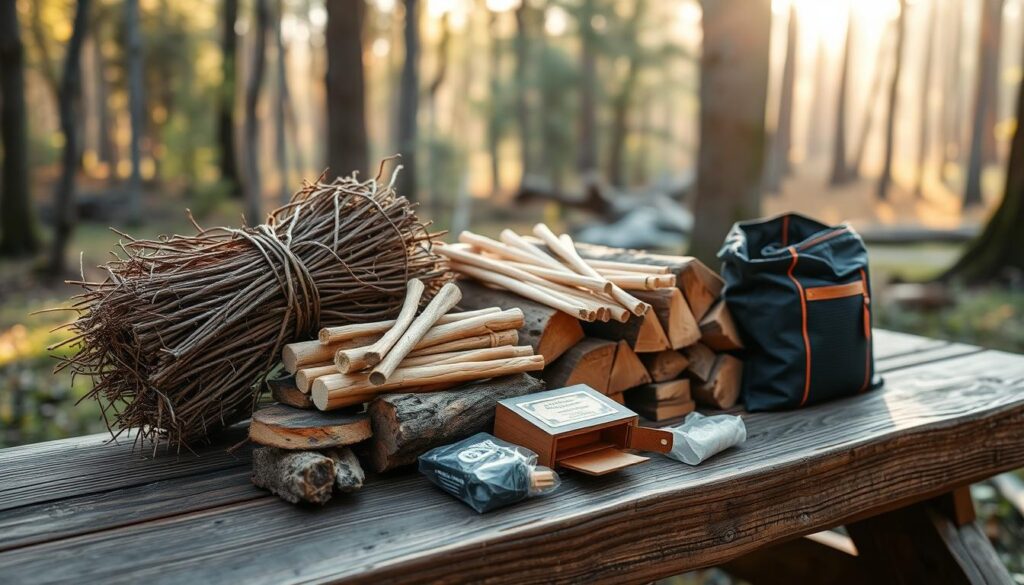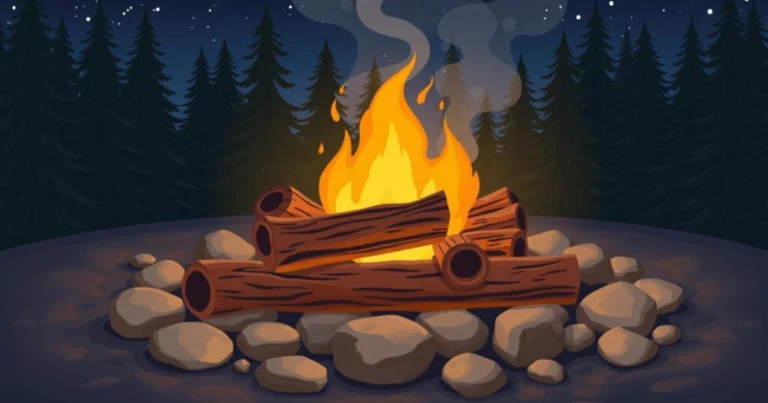How to Build a Campfire for Beginners – Simple Guide
Learning to build a campfire is key for outdoor lovers. It’s great for camping, backyard parties, or setting a cozy mood. This guide will show you how to start a campfire, from picking the right spot to keeping it burning.

Key Takeaways
- Understand essential campfire safety rules and location selection
- Gather the necessary materials and tools for building a campfire
- Familiarize yourself with different types of firewood and tinder
- Learn various fire-building techniques, such as the teepee and log cabin
- Discover effective methods for maintaining and managing your campfire
Essential Campfire Safety Rules and Location Selection
Building a campfire is a key part of outdoor fun. But, it’s vital to focus on fire safety and choose the right campsite. By sticking to safety rules and regulations, your camping trip will be safe and memorable.
Choosing the Perfect Spot for Your Campfire
Finding the right spot for your campfire is the first step in fire safety. Look for a place at least 30 feet away from anything that can burn, like trees or tents. Don’t pick a spot on dry grass or near branches that could fall.
Instead, find a flat, open area with little vegetation. This will help keep your fire safe and controlled.
Safety Distance Requirements and Regulations
Following fire regulations is key for safe campsite selection. Each area has its own rules about how close a campfire can be to other things. Make sure you know the local fire safety laws to keep your fire in check.
Weather Considerations for Fire Building
Check the weather before starting your campfire. Don’t light a fire in windy, dry, or humid conditions. These can make the fire spread easily.
If it’s raining, wait until the weather improves. This way, your campfire will be safe and enjoyable for everyone.
By following these campfire safety tips and picking a good campsite, you can have a great campfire experience. You’ll keep yourself and the environment safe.

Required Materials and Tools for Building a Campfire
Getting ready for a campfire means collecting the right campfire supplies and fire starting tools. You’ll need matches, lighters, fire starters, and safety gear. Having the right outdoor gear makes your outdoor adventure better.
Here’s what you need to build a campfire:
- Matches or a lighter – waterproof and windproof ones are best.
- Tinder – dry, flammable stuff like kindling, paper, or fatwood to start the fire.
- Kindling – small, dry sticks or twigs to quickly grow the fire.
- Firewood – a mix of sizes, from thin twigs to big logs, to keep the fire going.
- Fire starter – commercial or natural fire starters to help start the fire.
- Shovel or dirt – for safely putting out the fire when you’re done.
- Water – to fully put out the fire when it’s time to leave.
Having the right campfire supplies and fire starting tools makes for a safe and fun campfire. Always put safety first when making a fire outdoors.
| Campfire Supplies | Purpose |
|---|---|
| Waterproof matches or lighter | Ignite the tinder and kindling |
| Dry tinder | Help the fire catch and grow |
| Kindling | Fuel the fire and build it up |
| Firewood | Sustain the fire for long-lasting flames |
| Fire starter | Assist in igniting the tinder and kindling |
| Shovel and water | Safely extinguish the fire when finished |
With the right campfire supplies and fire starting tools, you’re ready to make a cozy campfire outdoors.

Understanding Different Types of Firewood and Tinder
Building a great campfire is more than just starting a spark. You need the right firewood and tinder to keep it going. Let’s explore the best materials for your next outdoor adventure.
Dry Tinder Options and Natural Fire Starters
Tinder is the first step to a campfire. Look for dry, fluffy stuff like cotton balls, dryer lint, or newspaper. Natural items like dead leaves, twigs, and pinecones also work well. But, stay away from wet or damp stuff. It won’t catch fire easily.
Kindling Selection and Preparation
- Kindling connects your tinder to the bigger firewood. Choose thin, dry sticks or branches, like a pencil’s thickness.
- Set up your kindling in a teepee or log cabin shape. This helps the fire breathe and spread.
Best Types of Firewood for Long-lasting Flames
Choosing the right firewood is key for a long-lasting campfire. Hardwoods like oak, maple, and birch burn longer and hotter. Softwoods like pine and cedar light up fast but burn out quicker. Mix them for the best fire.
For a great campfire, prepare well. Gather the right tinder, kindling, and firewood. Your outdoor time will be warmer, more fun, and perfect for making s’mores.
How to Build a Campfire for Beginners
Building a campfire might look hard for new campers. But, with the right steps, anyone can start a fire. We’ll show you how to build a campfire from start to finish. This way, you’ll have a fire that’s both warm and safe.
First, you need to gather the right stuff. You’ll need dry tinder, kindling, and different sizes of firewood. Tinder can be dry leaves, twigs, or cotton balls with petroleum jelly. Kindling should be small sticks to catch the spark. Firewood should be bigger to keep the fire going.
- Clear a circle about 3 feet wide, removing dry leaves or grass.
- Put down big logs or rocks for a strong fire base.
- Make a teepee with kindling, putting tinder in the middle.
- Light the tinder with a match, lighter, or fire starter. Gently blow on it to grow the flames.
- When kindling burns, add bigger firewood, keeping the teepee shape.
- Keep the fire going by adding wood as needed.
Always keep safety first when making a campfire. Choose a safe spot, keep away from flammable things, and never leave it alone. With these campfire building steps and fire starting techniques, even beginners can enjoy a cozy campfire.
Basic Fire Lay Techniques and Structures
Building a campfire is more than just throwing logs together. Learning fire lay techniques and different structures is key. Every beginner should know the teepee, log cabin, and lean-to methods.
Teepee Fire Structure Method
The teepee fire lay is simple and classic. Place tinder and kindling in the center. Then, lean larger logs in a cone shape, like a teepee.
This shape lets air flow well, helping the fire start and grow. It’s perfect for a quick, controlled burn.
Log Cabin Fire Layout
The log cabin method is great for a stable fire. Start with tinder and kindling in the center. Then, stack larger logs in a square or rectangle.
This creates a strong base for an even burn. It’s perfect for cooking or warming up for a long time.
Lean-to Fire Building Technique
The lean-to is best in windy weather. Place tinder and kindling in the center. Then, lean logs against a rock or log to make a shelter.
This keeps the fire safe from wind, ensuring a steady burn. It’s ideal for windy outdoor conditions.
Learning these fire lay methods makes you a better fire builder. It ensures your outdoor adventures are warm, cozy, and safe.
Maintaining and Managing Your Campfire
Keeping your campfire safe and enjoyable is key. As you enjoy the outdoors, remember these important tips for fire management, campfire safety, and extinguishing techniques.
First, watch the size of your campfire closely. A big fire might look cool, but it can get out of control. Try to keep the fire small, so it’s warm and cozy without being dangerous.
Regulating the Fire’s Size and Heat
- Add fuel (firewood) in small, controlled amounts to prevent the fire from growing too large.
- Adjust the airflow by opening or closing the fire pit’s vents or adjusting the placement of logs to control the intensity of the flames.
- Use a fireproof tool, such as a long stick or poker, to rearrange the burning wood and maintain an even, consistent fire.
Safely Extinguishing the Campfire
When it’s time to leave, make sure to extinguish the campfire properly. Never leave a fire alone, as it can start a big wildfire.
- Allow the fire to burn down completely, reducing it to a pile of embers.
- Carefully pour water over the entire area, ensuring that all embers are fully extinguished.
- Stir the ashes and embers with a shovel to expose any remaining hot spots, then douse them with more water.
- Once the fire is completely out, feel the area with your hands to ensure it is cool to the touch before leaving the site.
By following these simple fire management and campfire safety practices, you can have a great, safe outdoor adventure.
“The true conservationist is a man who knows that the world is not given by his fathers, but borrowed from his children.” – John James Audubon
Conclusion
In this guide, we’ve covered the key skills for building a campfire like a pro. You now know how to pick the right spot, follow safety rules, and arrange firewood. This knowledge lets you make outdoor fires that are both safe and enjoyable.
Building a campfire is more than just starting a fire. It’s about respecting nature and using resources wisely. By following this guide, you can enjoy campfires safely and responsibly. This way, you can create warmth, ambiance, and memories while protecting the environment.
When you’re outdoors, stay alert and ready to adapt. Use your campfire skills to connect with nature and make memories. Keep an eye on fire safety and respect the outdoors. You’re on your way to becoming a campfire expert.
FAQ
What are the essential campfire safety rules and location selection considerations?
Choosing the right spot for your campfire is key. You need to know the safety distance and follow the rules. Also, check the weather to ensure a safe outdoor adventure. Always practice safe fire management to avoid accidents and protect nature.
What materials and tools are required for building a successful campfire?
Getting the right materials and tools is important. You’ll need matches or lighters, fire starters, tinder, kindling, and firewood. Don’t forget safety gear like a shovel and water.
What are the different types of firewood, tinder, and kindling, and how do they affect the campfire?
The type of firewood, tinder, and kindling you use matters a lot. Dry tinder and natural fire starters help. Properly prepared kindling and the right firewood ensure long-lasting flames.
What are the step-by-step instructions for building a campfire for beginners?
Starting a campfire for the first time can be tough. But, this guide makes it easy. It covers everything from gathering materials to keeping the fire going.
What are the different fire lay techniques and structures, and when should each be used?
Knowing different fire lay methods is useful. Techniques like the teepee, log cabin, and lean-to help with various conditions. It’s important to know when to use each.
How do I properly maintain and manage my campfire?
Keeping your campfire steady and safe is crucial. Managing its size and heat is important. Also, learn how to safely put out the fire when you’re done. This section has tips for safe fire management.



